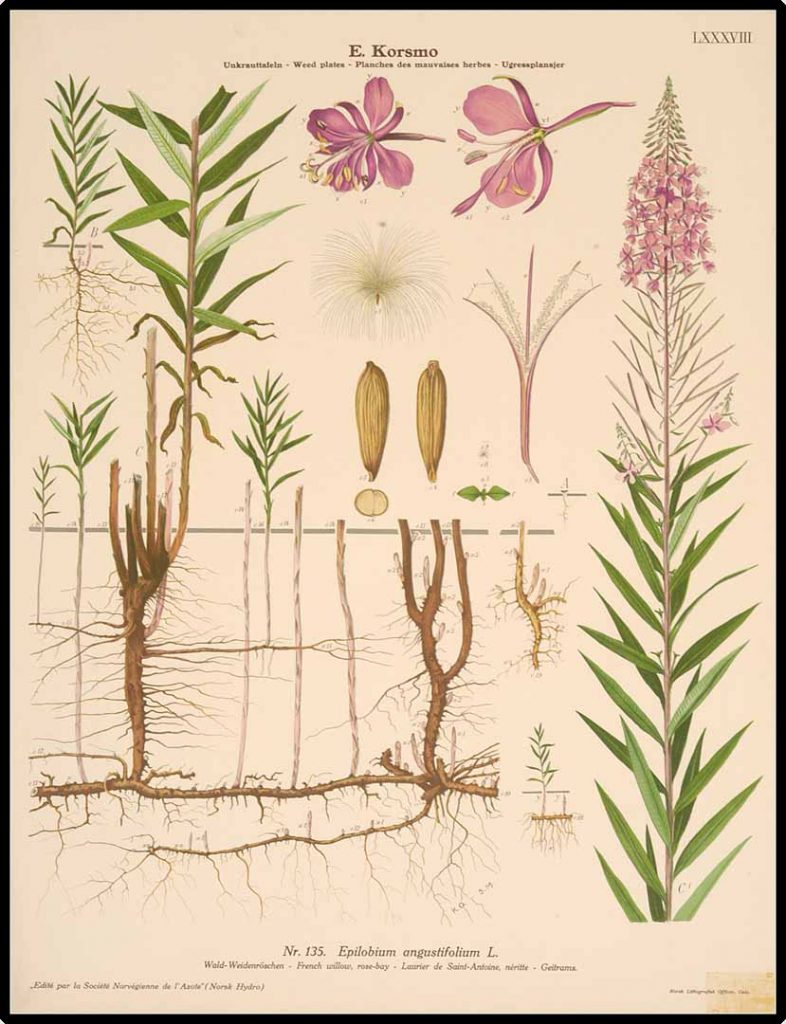
from Plantillustrations.org
Chamaenerion angustifolium, known in North America as fireweed, in some parts of Canada as great willowherb, in Britain and Ireland as rosebay willowherb, and traditionally known as Saint Anthony’s Laurel amongst other variants, is a perennial herbaceous flowering plant in the willowherb family Onagraceae. It is also known by the synonyms Chamerion angustifolium and Epilobium angustifolium. It is native throughout the temperate Northern Hemisphere, including large parts of the boreal forests.
The specific epithet angustifolium (‘narrowleaved’) is constructed from the Latin words angustus meaning ‘narrow’ and folium meaning ‘leaved’ or ‘leaf’. It shares this name with other species of plant including Vaccinium angustifolium. The common British name, from the passing resemblance of the flowers to (wild) roses and the leaves to those of bay, goes back in print to Gerard’s Herball of 1597.
Leaves used as fermented tea. The very young shoots and leaves can be cooked and eaten.
Traditionally the young shoots are collected in the spring by Native American and Siberian people and mixed with other greens. As the plant matures, the leaves become tough and somewhat bitter. The southeast Native Americans use the stems in this stage. They are peeled and eaten raw. When properly prepared soon after picking they are a good source of vitamin C and pro-vitamin A. The Dena’ina add fireweed to their dogs’ food. Fireweed is also a medicine of the Upper Inlet Dena’ina, who treat pus-filled boils or cuts by placing a piece of the raw stem on the afflicted area. This is said to draw the pus out of the cut or boil and prevents a cut with pus in it from healing over too quickly.
The root can be roasted after scraping off the outside, but often tastes bitter. To mitigate this, the root is collected before the plant flowers and the brown thread in the middle removed.The stem centers can also be prepared by splitting the outer stalk, and eaten raw.
In Russia, fireweed is made into a tea known as Ivan Chai. They use it as highly prized medicinal herb too.
In the Yukon, the flowers from fireweed are made into jelly.
It’s natural variation in ploidy has prompted its use in scientific studies of polyploidy’s possible effects on adaptive potential and species diversification.
It is also grown as an ornamental plant. A white form, C. angustolium ‘Album’ is listed by the Royal Horticultural Society
Depictions in human culture
Fireweed is the floral emblem of Yukon.
In The Fellowship of the Ring, J.R.R. Tolkien lists fireweed as one of the flowering plants returning to the site of a bonfire inside the Old Forest.
As the first plant to colonise waste ground, fireweed is often mentioned in postwar British literature. The children’s novel Fireweed is set during the Blitz and features two runaway teenagers who meet on bomb sites where fireweed is growing profusely. Another children’s novel, A Reflection of Rachel features a protagonist attempting to restore an old garden that used “Rose Pink Willow Herb” as an ornamental plant and mentions its notoriety for growing on abandoned bomb sites. Cicely Mary Barker’s 1948 book Flower Fairies of the Wayside included an illustration of ‘The Rose-Bay Willow-Herb Fairy’, with the accompanying verse “On the breeze my fluff is blown; So my airy seeds are sown. Where the earth is burnt and sad, I will come to make it glad. All forlorn and ruined places, All neglected empty spaces, I can cover—only think!— With a mass of rosy pink.”
Rosebay Willowherb was subsequently voted the county flower of London in 2002 following a poll by the wild plant conservation charity Plantlife.
Read more on Wikipedia